
This post is part of the LTER’s Short Stories About Long-Term Research (SSALTER) Blog, a graduate student driven blog about research, life in the field, and more. For more information, including submission guidelines, see lternet.edu/SSALTER
Morning in the Midnight Sun
Fairbanks, Alaska isn’t always the snow-covered tundra that most of us in the lower 48 would imagine. By June, the Interior of Alaska is a balmy 70 degrees, willows and wild rose are blooming, the mosquitos are out, and the Midnight Sun is at its peak, giving residents over 21 hours of sunlight a day. After an inevitably arduous series of flights (somehow, all flights into Fairbanks are red-eyes), a summer field team can’t help but be excited either way. The field season might be short, with many non-resident researchers arriving in June and leaving before the end of August, but like everyone in Fairbanks they know how to make the most of it.

Credit: Eleanor Serocki, CC BY-SA 4.0.
Field days start early. Though the Alaska Peatland Experiment (APEX) is located only 45 minutes out of town, there’s always gear to prep, devices to calibrate, and (most importantly) snacks to pack. The infrared gas analyzer, or IRGA, that the team uses to measure the amount of CO2 in the air, needs to be calibrated before heading out, then carefully packed away with its cables, an impressively thick laptop and, most high-tech, enough batteries to make sure it runs all day.
By 8, the team hits the road in a truck now older than some of them, miraculously playing music over the radio using a blu-tooth adaptor. The truck might not have air conditioning or power windows, but she does have spirit and a non-functional tape deck. Heading out over the Parks Highway towards the Bonanza Creek Experimental Forest, they keep a keen eye to see if they can spot Denali in the distance. Clear “Denali Days” are always a sign of good luck: few mosquitos, charged batteries, and minimally squished sandwiches. No one is going to over top their knee boots on a Denali Day.

Credit: Eleanor Serocki, CC BY-SA 4.0.
From Forest to Fen
Parking on the edge of a bumpy forest road at the base of the picnic spot locals just call “the Bluff” it’s a short walk into the study site. “Alpha” is a rich fen. A common ecosystem here in interior Alaska, rich fens are a type of peatland, where due to water and cool temperatures the microbes in the soil can’t eat away at dead leaves and roots faster than the plants can make them. This leaves behind thousands of years of undecomposed plant matter on top of the mineral soil called “peat”, a locked box of carbon stored in the soil, rather than going back into the atmosphere. This means that peatlands, like our friendly fen Alpha, have usually been “sinks” of carbon into the soil, rather than “sources” to the atmosphere.
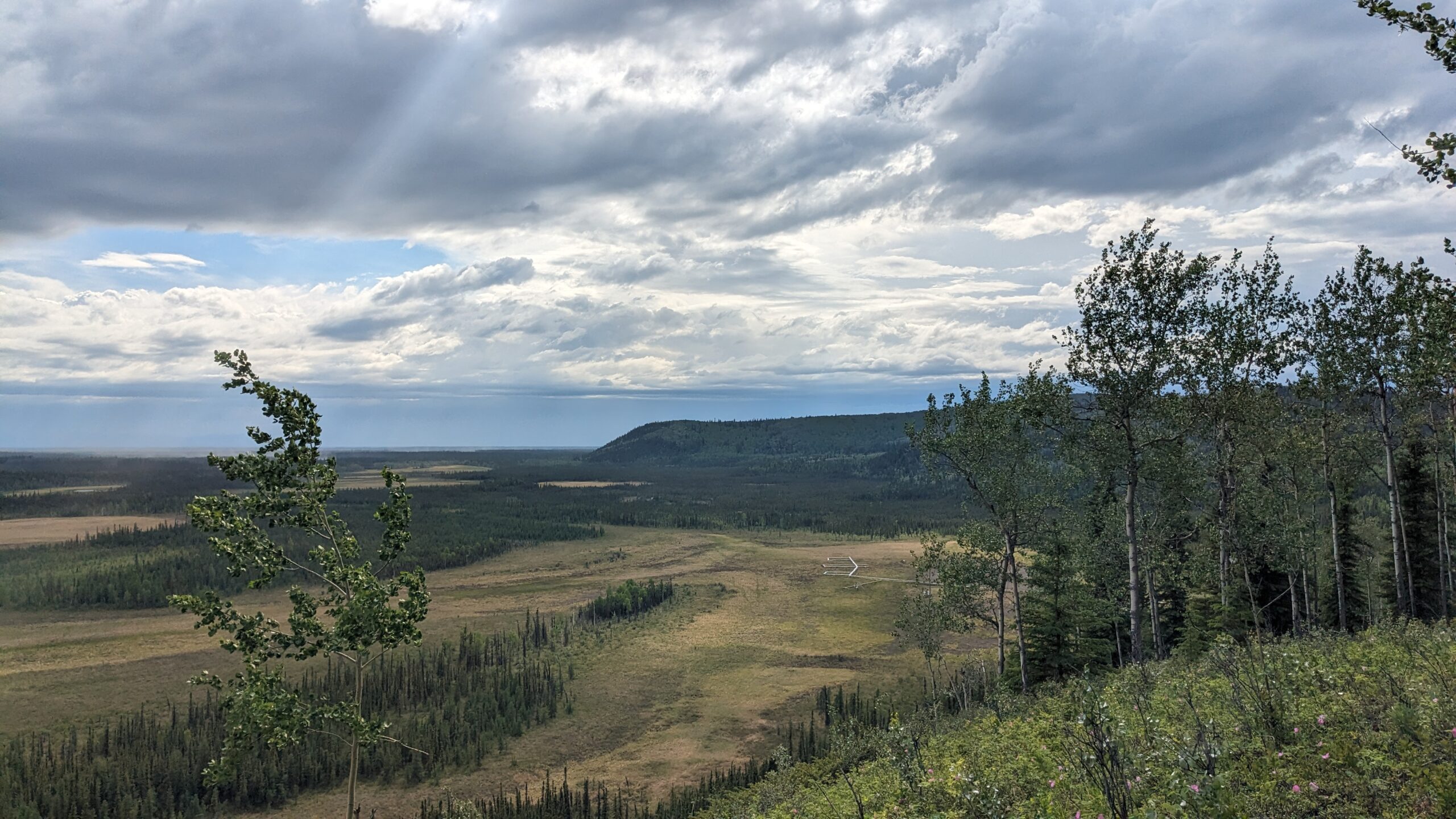
Credit: Eleanor Serocki, CC BY-SA 4.0.
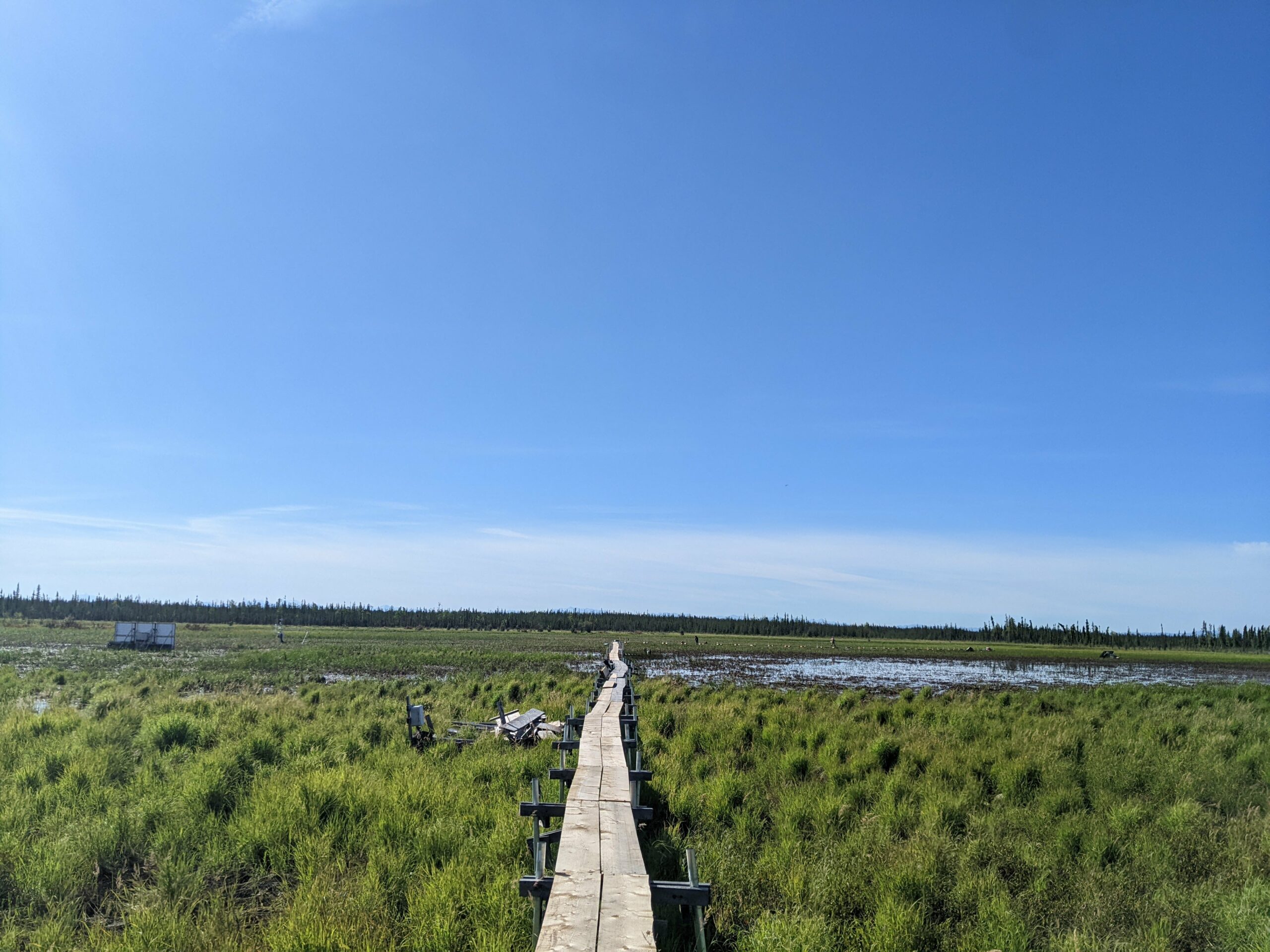
Credit: Eleanor Serocki, CC BY-SA 4.0.
It’s because of this peat that our team is here today. Peatlands only cover about 3% of the land on earth, but store upwards of 25% of soil carbon, a fact peatland scientists will usually tell you within the first ten minutes of meeting them. Because of this locked up carbon, they are key to the carbon cycle and may have a huge impact on climate change. If the microbes were able to start eating at those thousands of years of stored carbon, sending it back into the atmosphere, climate change could start accelerating. So how is that carbon stored? And how might that storage change in the future?
With those questions in mind, APEX was founded in 2005. The experiment aimed to change the water table in a fen to see how carbon storage would change when the water was at different levels. Along a boardwalk, areas are drained or flooded using solar powered pumps and this difference, as well as a control plot, may be able to tell us what the different futures of peatland carbon may be.

Credit: Eleanor Serocki, CC BY-SA 4.0.
Science Box and the Secrets of the Moss
Using a convoluted series of ladders like draw bridges, the team locates each of the collars installed into the soil. These collars are metal squares lined with foam and when topped with a closed plexy chamber, lovingly called Science Box, they make a closed system. This allows the IRGA to see the change in concentration of CO2 within the box over time. When we take into account the size of Science Box, we can then calculate a rate at which CO2 is entering or leaving the soil. CO2 concentrations will go down when the plants are happily photosynthesizing away, using the carbon in atmospheric CO2 to build delicious sugars and starches to store in their leaves and stems. The concentration of CO2 goes up as the microbes are eating away at the dead plant tissues that make up the peat, breathing out CO2. By measuring the changes in CO2 in full sun and again shrouded by a tarp, the technicians can piece out which parts of this “flux” are the plants, and which are the microbes. While both are chugging along in the sun, shrouding “turns off” the plants, meaning only the microbes are causing the change. Subtracting the shrouded rate (Ecosystem Respiration) from the sunny rate (Net Ecosystem Exchange) we can learn what the plants are up to (Gross Primary Product). Historically, peat builds up as the plants “win” the balance, but this might be changing.
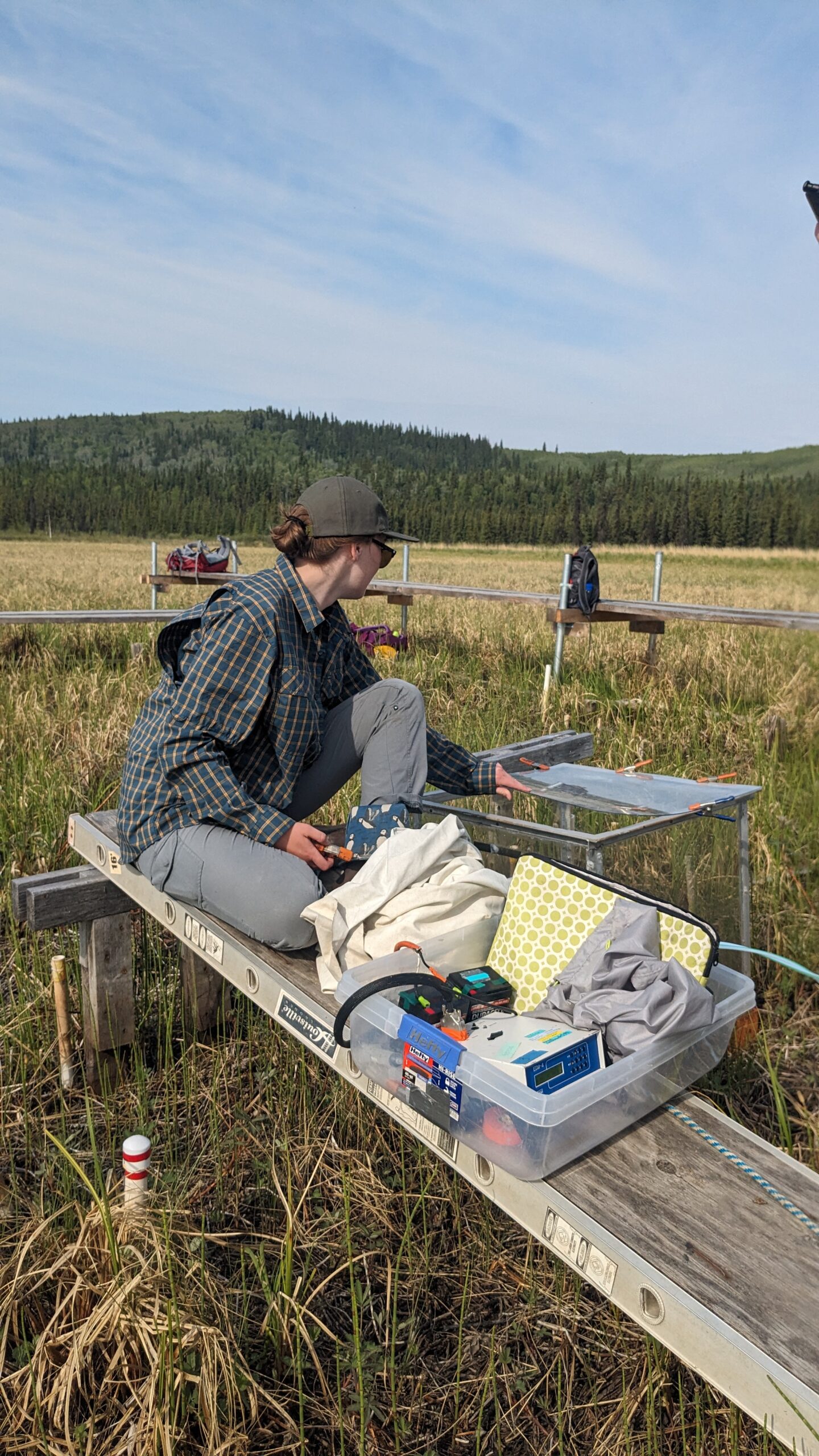
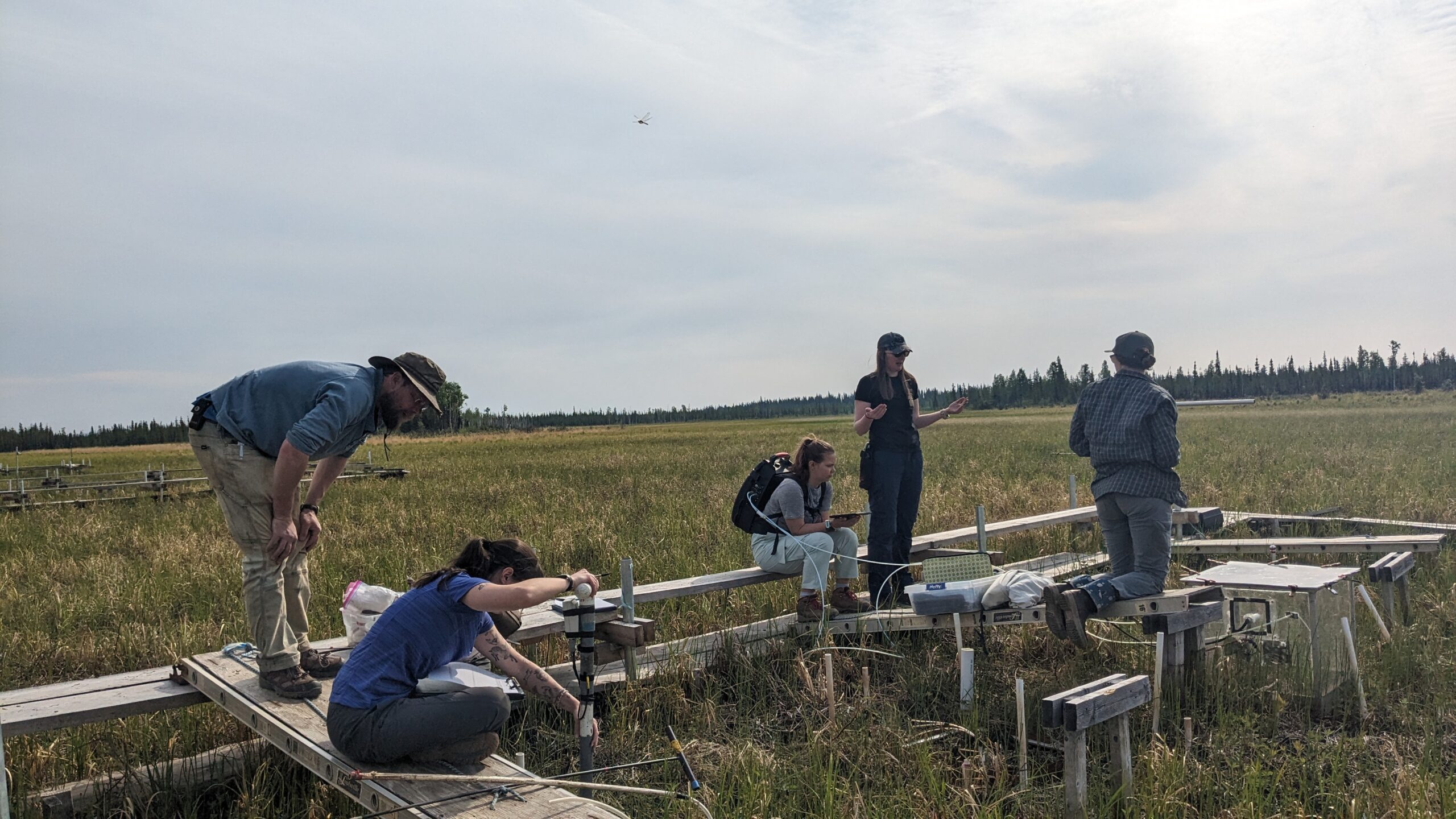
Left: Field Technician Sarah Kennings flushes a chamber to ensure the concentration of CO2 inside matches the ambient atmosphere around it. After ceiling the container with the orange clips shown, the IRGA (photo center, in clear box) will be able to measure how the concentration inside changes, allowing scientists to calculate the rate of CO2 change, or gas flux.
Right: PI’s Dr. Evan Kane (Michigan Technological University) and Dr. Catherine Deilimean (University of Guelph) work at the start of the 2024 summer field season to introduce that years field team (sitting, left to right, Alyssa Tinella, Kaija Windeler, Sarah Kennings). The team perch on ladders which have been carefully lowered onto wooden “T”s in the soil (visible in center of photo) in order to reach plots.
Credit: Eleanor Serocki, CC BY-SA 4.0.
By mid-day, even in Alaska the sun feels fierce. The interior doesn’t get much precipitation, so the team lovingly bullies each other into drinking enough water. Thankfully rich fens don’t have trees, meaning a light breeze is able to keep off the worst of the bugs. Finding the collars and fitting the chamber into place can be an art of boardwalk yoga: stepping on the soil could kill plants or squish out gasses held in the pores, impacting the measurements. While one person runs the IRGA to collect CO2, another Science box is being used to collect gas into syringes to measure methane back in the lab. Another team member is able to quickly move plot to plot, measuring environmental data such as soil temperature, water table depth, and water chemistry.
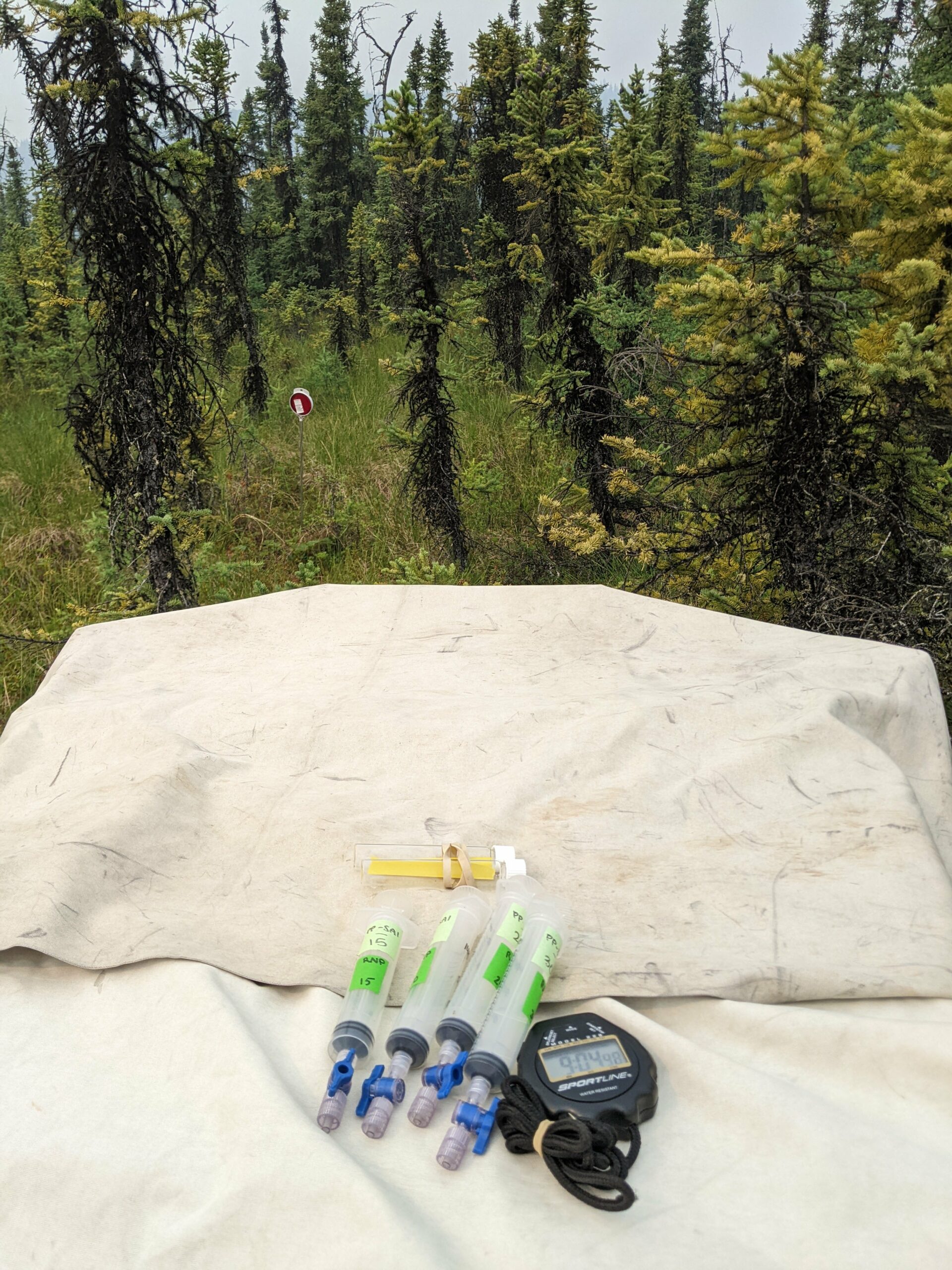
Credit: Eleanor Serocki, CC BY-SA 4.0.
Making Data into Science
By 5pm, the team is tidying up, making sure that equipment and samples are packed, snack wrappers tucked away, and the chambers stored for next time. The sun is still high in the sky, but it’s cooled off and the light has moved. Ravens call to each other, and if you’re lucky, a moose will appear out of the woods on the far side of the fen to munch on plants. Rattling back up the road, the team checks in and makes plans for dinner and, on particularly good or bad days, an ice cream stop after finishing up in the lab.
A fat folder of filled field sheets and a box of methane samples are the results of a day’s labor. Now those numbers need to become science: carefully entered and double checked into excel sheets, samples run on a mysterious gray box in the lab called a Gas Chromatographer, compared and calculated against years of information. These samples will be one more collection in an over 20 year long program, documented by dozens of students who are now teachers. This long collection of data may just let us know what the fen is up to, how it is changing, and what it could mean for the globe.
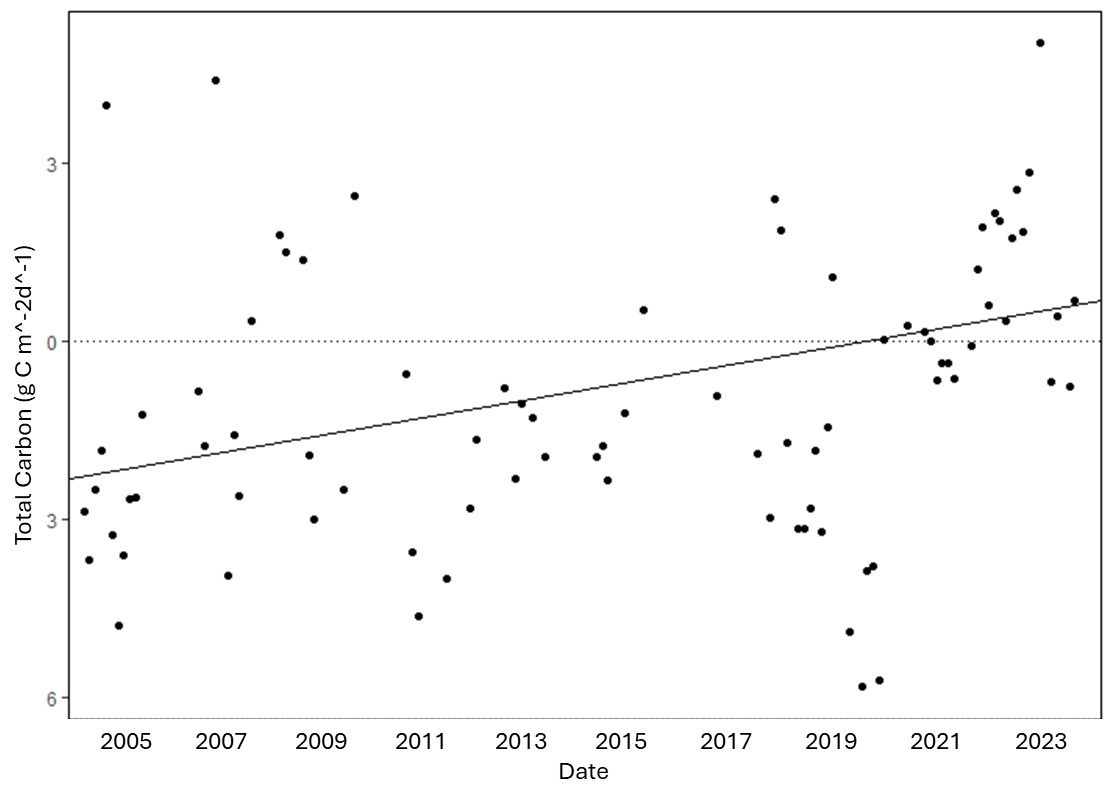
Credit: Eleanor Serocki, CC BY-SA 4.0.

Eleanor Serocki is a PhD student who studies carbon flux dynamics and remote sensing in the Kane lab at Michigan Tech. She works with the Bonanza Creek LTER site.










